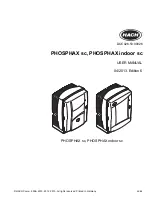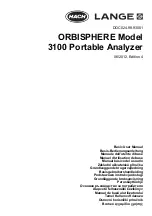
CATV Measurements
5–60
2715 User Manual
CROSS MODULATION Measurement
The spectrum analyzer has two methods for measuring cross modulation: Time
Domain NCTA (National Cable Television Association) and Frequency Domain.
You can select the method from the CROSS MODULATION measurement menu
(refer to Enable CROSS MODULATION Measurement on page 5–61).
Both methods measure and record the cross modulation in the current channel.
For meaningful calibration, both methods require using the system stimulation
recommended by the NCTA. This stimulation requires the following:
H
All carriers (except the channel under test) must be synchronously modulated
100% with a horizontal rate square wave.
H
The channel under test must carry an unmodulated CW carrier.
The two methods measure cross-modulation effects on the CW carrier in
fundamentally different ways.
The Time Domain (NCTA) method tunes the spectrum analyzer to the visual
carrier frequency, sets ZERO SPAN, and then detects any modulation with an
envelope detector. A Fourier analysis is performed on the output of the detector
to assess the amplitude of the modulation at the horizontal rate. The result is
scaled and reported in units of dBc.
The Time Domain (NCTA) method closely conforms to the recommended NCTA
procedure. This method is often thought to most accurately reflect the level of
visible picture impairment. However, this may not be the best method for
measuring sideband amplitudes, since cross modulation can also occur as phase
modulation, which the envelope detector used by this method does not detect.
Therefore, the cross modulation sidebands can have significantly higher
amplitudes than indicated by the Time Domain measurement result. This may
result in picture impairment arising from phase modulation to amplitude
modulation conversion in the asymmetric IF filter of the TV receiver, and may
lead to failure to detect coherent disturbances in excess of legal limits.
NOTE
. The Frequency Domain method is sensitive to the accuracy of the
frequency of the visual carrier when the frequency is defined in the channel table
(refer to Channel Tables on page 5–6). If the channel under test has an
aeronautical offset of 12.5 kHz and the offset is not accounted for in the channel
table, then the cross modulation measurement may not find the 15.73 kHz
sidebands. If the sidebands are not found, the measurement will abort.
The Frequency Domain method reliably detects sidebands arising from either
amplitude modulation or phase modulation (or a combination of both). Also, the
useful measurement range of the Frequency Domain method is significantly
greater than that of the Time Domain method.
Содержание 2715
Страница 4: ......
Страница 12: ...Table of Contents viii 2715 User Manual ...
Страница 18: ...Preface xiv 2715 User Manual ...
Страница 19: ...Introduction ...
Страница 20: ......
Страница 24: ...Introduction 1 4 2715 User Manual ...
Страница 25: ...Getting Started ...
Страница 26: ......
Страница 46: ...Getting Started 2 20 2715 User Manual ...
Страница 47: ...Operating Basics ...
Страница 48: ......
Страница 70: ...Operating Basics 3 22 2715 User Manual ...
Страница 71: ...Dedicated Controls ...
Страница 72: ......
Страница 108: ...Dedicated Controls 4 36 2715 User Manual ...
Страница 109: ...CATV Measurements ...
Страница 110: ......
Страница 181: ...Spectrum Analyzer Menus ...
Страница 182: ......
Страница 274: ...Spectrum Analyzer Menus 6 92 2715 User Manual ...
Страница 275: ...Appendices ...
Страница 276: ......
Страница 302: ...Appendix B Broadcast AM FM and TV Signal Sources B 2 2715 User Manual ...
Страница 318: ...Appendix C System Messages C 16 2715 User Manual ...
Страница 334: ...Appendix E External Input and Output E 12 2715 User Manual ...
Страница 339: ...Glossary and Index ...
Страница 340: ......
Страница 359: ......
Страница 360: ......
















































